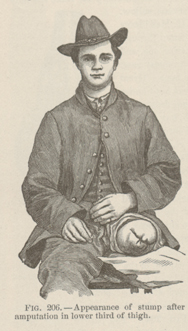Title: Rist, Cutler H.
Source text: The Medical and Surgical History of the War of the Rebellion. (1861-65.), Part 3, Volume 2 (Washington, DC: Government Printing Office, 1883), 318.
Civil War Washington ID: med.d2e14385
TEI/XML: med.d2e14385.xml
CASE 492.—Private Cutler H. Rist, Co. A, 36th Wisconsin, aged 18 years, was wounded at Cold Harbor, June 1, 1864, by a conoidal ball, which entered on the inner and posterior portion of the left leg and caused a fracture of the tibia, which extended into the knee joint. He was immediately conveyed to the field hospital of the 2d division, Second Corps, where amputation at the knee joint was performed by Surgeon J. M. Burr, 42d New York. On June 11th, he was admitted into Lincoln Hospital, Washington, where Acting Assistant Surgeon C. H. Bowen reported: "Date of operation, June 3d; amputation at knee joint, leaving patella and condyles of femur." Dr. Bowen adds: "Having seen several of these operations performed, they have all died in periods varying from six to twenty days, from pyæmia, tetanus, etc., I totally discard the operation: 1st, from the extensive suppuration from the condyles of the femur and from the patella, from the duration of the suppuration, which will continue until the entire cartilaginous substance from condyles and patella is either cut away or has sloughed off by the work of nature, after which comes the continuous discharge of the synovial fluid from the wound. In the case of Rist, in which the limb was amputated on June 3, 1864, the synovia still exudes, in December, 1864, in quantities varying from a teaspoonful to a tablespoonful, and more especially, after the least exertion, such as walking by means of crutches; besides, the cicatrix is of a sloughing character, tending to gangrene. December 14th, amputation not healed; continuous discharge of synovial fluid, more especially when walking; tendency to slough; patient otherwise in a healthy condition, and desires a re-amputation, and, in my opinion, the stump will never heal while remaining in its present condition." On December 15, 1864, Assistant Surgeon J. C. McKee, U. S. A., amputated the thigh at the lower third; skin flap and circular section of muscles. Simple dressings were applied. The patient recovered rapidly. He was transferred to Harvey Hospital, Madison, Wisconsin, on March 23d, and discharged from service May 20, 1865. His pension was paid March 4, 1879. Dr. McKee contributed a photograph of the patient (Contributed Photographs, Vol. II, p. 25), which is reproduced in the wood-cut (FIG. 206), and the pathological specimen which consists of "the extremity of the left femur and the soft tissues forming the stump after amputation through the knee joint." (Catalogue of Surgical Section, A. M. M., 1866, p. 502, Spec. 3514.)
